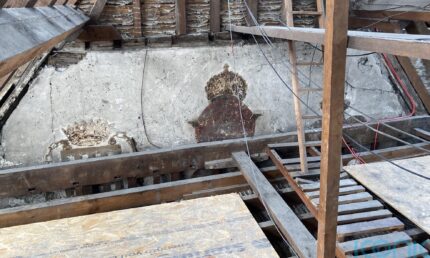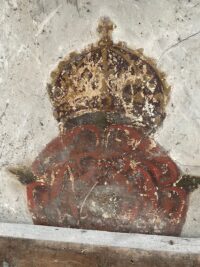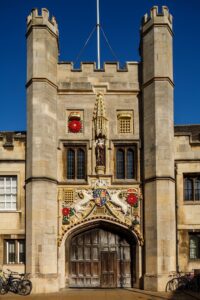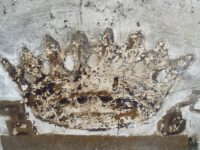 Builders restoring the roof of a 16th century building at Christ’s College, Cambridge University, have discovered three wall paintings hidden behind a wooden roof joist. The wall paintings depict a crowned portcullis, a crowned red Lancaster rose and a third motif that is partially obscured but is likely a fleur-de-lis. These motifs are all elements of the family crest of the foundress of Christ’s College, Lady Margaret Beaufort, mother of King Henry VII.
Builders restoring the roof of a 16th century building at Christ’s College, Cambridge University, have discovered three wall paintings hidden behind a wooden roof joist. The wall paintings depict a crowned portcullis, a crowned red Lancaster rose and a third motif that is partially obscured but is likely a fleur-de-lis. These motifs are all elements of the family crest of the foundress of Christ’s College, Lady Margaret Beaufort, mother of King Henry VII.
The paintings were found in First Court, the oldest part of Christ’s College dating to the 15th century, in the roof over the northwest wall of the original library. They extend over 20 feet and were painted directly onto the plaster. Limewash was applied around the artworks to make them stand out.
 Originally founded as God’s House, a school for grammar teachers, in 1437, it was enlarged and refounded as Christ’s College by Margaret Beaufort in 1505. She financed the transformation of a modest school into a fully-fledged college of Cambridge University, donated 39 books to form the kernel of its prestigious library, endowed it with two estates complete with their manors and spent £1625 on construction for the college between 1505 and 1509. She bequeathed even more of her properties to Christ’s College in her will, guaranteeing that it would have the steady income needed to thrive as an educational institution for centuries after her death.
Originally founded as God’s House, a school for grammar teachers, in 1437, it was enlarged and refounded as Christ’s College by Margaret Beaufort in 1505. She financed the transformation of a modest school into a fully-fledged college of Cambridge University, donated 39 books to form the kernel of its prestigious library, endowed it with two estates complete with their manors and spent £1625 on construction for the college between 1505 and 1509. She bequeathed even more of her properties to Christ’s College in her will, guaranteeing that it would have the steady income needed to thrive as an educational institution for centuries after her death.
 Lady Margaret’s legacy is embedded in the architecture of Christ’s College. The family coat of arms, the portcullis of the Beaufort family, the red rose, the badge adopted by Henry VII as the first Tudor king, the white Marguerite (daisy) that was Lady Margaret’s personal emblem and the family motto “Souvent me souvient” (“I often remember”) are found on walls, over doorways and in monumental format over The Great Gate, the entrance into Christ’s College that still boasts its original 1509 oak door.
Lady Margaret’s legacy is embedded in the architecture of Christ’s College. The family coat of arms, the portcullis of the Beaufort family, the red rose, the badge adopted by Henry VII as the first Tudor king, the white Marguerite (daisy) that was Lady Margaret’s personal emblem and the family motto “Souvent me souvient” (“I often remember”) are found on walls, over doorways and in monumental format over The Great Gate, the entrance into Christ’s College that still boasts its original 1509 oak door.
Cambridge University art historian Dr Christina Faraday said: “This is a really exciting and unusual discovery.” […]
Dr Faraday, who specialises in Tudor visual and material culture, said the works revealed “the ways that the college celebrated and advertised its royal patron during the early years of the 16th Century, following its re-founding”.
“A powerful and pious woman, with a keen interest in scholarship, Lady Margaret left her indelible mark on the college,” Dr Faraday said.
“The wall paintings are an early example of her family’s savvy use of visual ‘branding’ even beyond the royal court. Henry VII had a very weak claim to the throne, but became adept at using visual symbols like this to promote his kingship.”
 It’s rare for murals like these to survive centuries of refurbishments. They were inexpensive decorations to begin with so there was little incentive to go to the trouble of preserving them when changes were made to the buildings. Researchers checked the archives after the murals were rediscovered and the last eye-witness account of the wall paintings was recorded in around 1738.
It’s rare for murals like these to survive centuries of refurbishments. They were inexpensive decorations to begin with so there was little incentive to go to the trouble of preserving them when changes were made to the buildings. Researchers checked the archives after the murals were rediscovered and the last eye-witness account of the wall paintings was recorded in around 1738.
The paintings were preserved by benign neglect thanks to their covered location in the roof. That location also means they won’t go on display, unfortunately. They will, however, be restored and stabilized in situ.